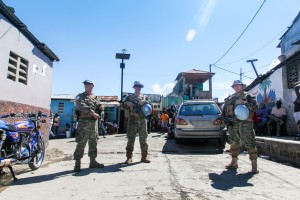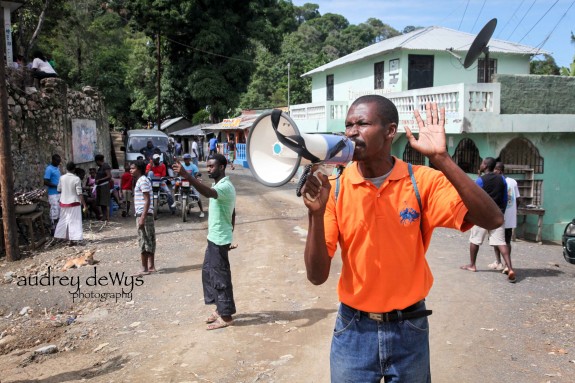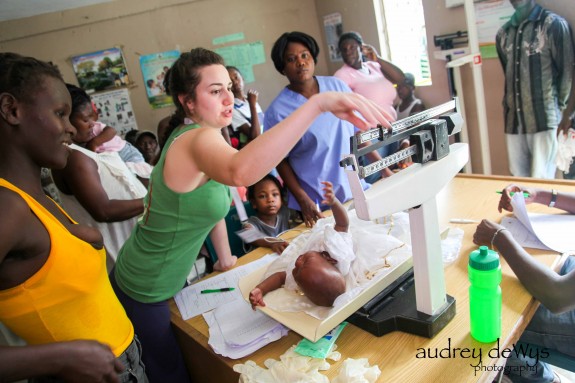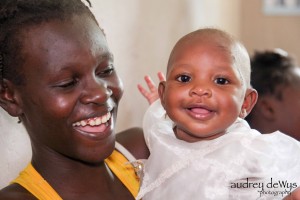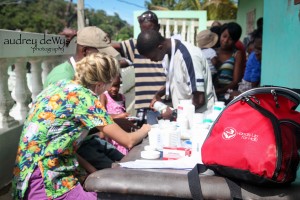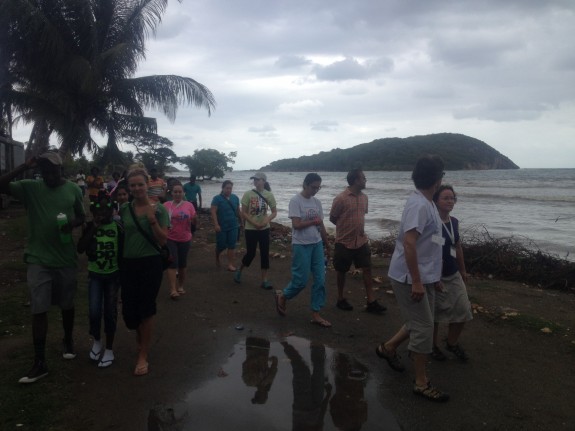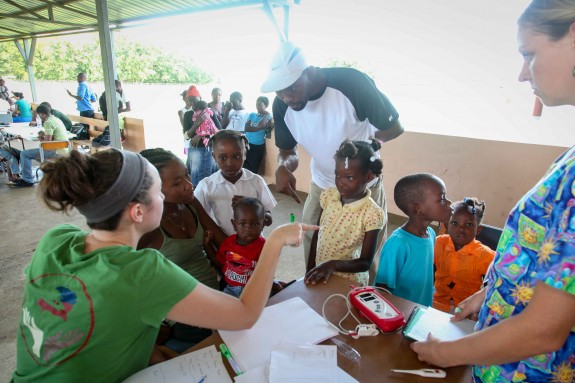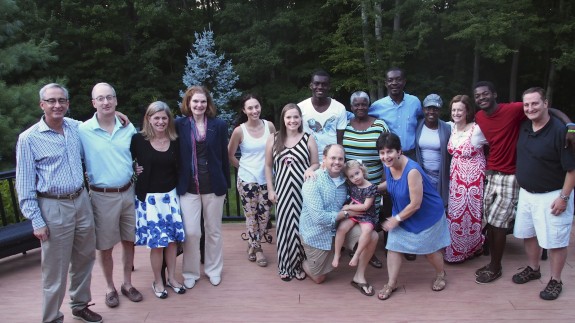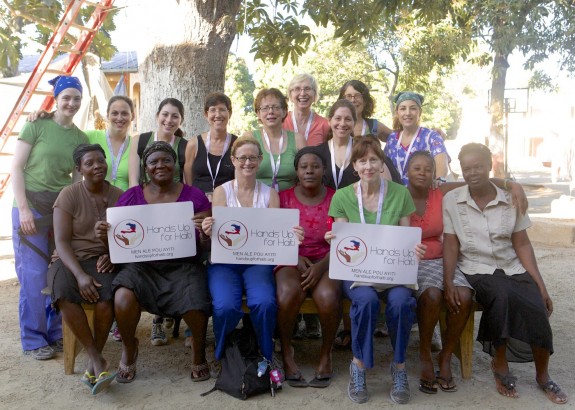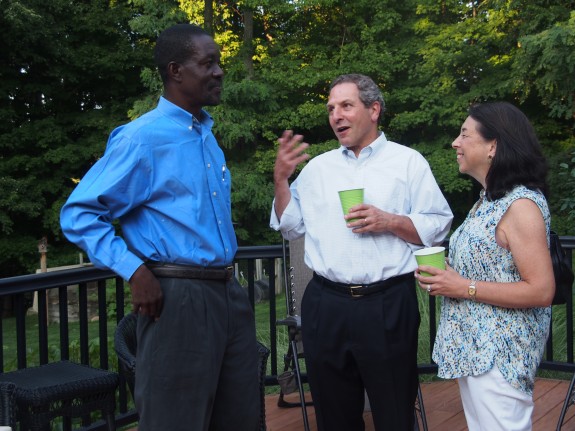By Celeste Theis, a social worker recently returned from the January 2015 mission to Haiti:
Our team of eleven, doctors, nurses, nutritionists, a social worker and an occupational therapist, and one volunteer from outside the health care world, came to Cap Haitien this past January on an HUFH pediatric mission. Some of us had been to Haiti with HUFH in 2014, when we met Maud Dugue, a Haitian businesswoman and the founder of Club Evangelize. Maud opened her home to the children in her neighborhood about 10 years ago; there she holds Saturday classes to teach the children basic academic skills. When we came in 2014, Maud graciously invited our team to her home to talk about her efforts to help the local kids. In addition to teaching academics, Maud sought out people who could teach the children marketable skills such as sewing, auto repair, and electronics. Dedicated to her children, Maud acquired funding to build a new school building just up the street from her home. Last year, the HUFH team walked to the new three story building; although still under construction, we knew it was going to be wonderful asset to the community.

The team sets up the class.
That was our ah-hah moment: It was then that my friend and team member Alice and I hatched the idea to come back and conduct a sewing lesson for “Maud’s kids”. Alice and I both love to sew, and it seemed like a worthwhile skill to teach the kids. Our initial visit to Club Evangelize occurred on the last day of our visit to Haiti in 2014. But Alice and I were already pretty sure that we would return with HUFH the following year.
Once back at home, Alice and I put out the word to friends, co-workers, and anyone who would listen that we were seeking donations of sewing machines, fabric, thread, and various sewing supplies. We managed to collect 8 sewing machines and lots of fabric and supplies. These were shipped to Club Evangelize well in advance of our 2015 trip. I had been in email contact with Maud about the plan to visit her school for a morning to conduct a sewing lesson for the students. She was delighted, and informed me that there were many more students who were interested in learning to sew than we could reasonably teach in a few hours.

Volunteer Lynn Perton helps a student.
In the months prior to our January 2015 trip, much had to be arranged: We had communicated with Maude that we felt we could work with about 25 kids in the time that we had to be at the school. Well in advance of our visit, sewing machines and supplies had to be shipped from here and picked up by our HUFH team when they arrived in Haiti. Maud would be responsible for getting the supplies unpacked and readied for the day we would arrive.
Meanwhile, Alice and I brainstormed to come up with a simple sewing project for the kids. We would teach them how to operate the machines, measure and cut the fabric, do some simple decorative stitching, and add some embellishments to make headbands. It would be quick, easy, fun – AND, most importantly, the kids could continue to make the headbands (and perhaps other projects) on their own after we left. The sewing machines and supplies had been donated to Club Evangelize and would remain there. Great plan, right?

Celeste Theis teaches sewing skills.
Well….it’s Haiti. A couple of weeks before our trip, Maud informed me that her school does not have electricity. That was a basic erroneous assumption on my part. Although, in my defense, having visited the school last year while it was still under construction, it appeared that it would be a fairly modern, 3 story structure. But I did not realize that in Haiti, even a “modern” building used for a school may not have regular electricity. No problem. HUFH would rent a generator for the sewing lesson. All would be well.
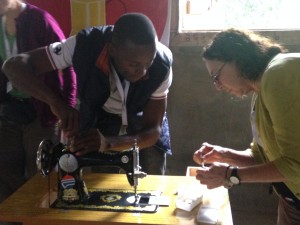
Nurse Elise Lentz threads the needles.
On the day of our visit to Club Evangelize, we arrived to find that none of the 13 boxes of supplies that we shipped had been unpacked (including the sewing machines). Our team of 11, along with our translators, got to work, unpacking the boxes, and arranging fabric and supplies on the tables. This was all happening while the kids were arriving. Our translators set up the generator to power the sewing machines. But when one of our translators, Sonnel, pulled the cord to start the generator, it broke off in his hand! Volunteer Dan Haskell, a master problem solver, set about to fix the generator with his bicycle cords. But would it work? Meanwhile new plan: make the headbands by hand.

Volunteer Dan Haskell donates his bicycle cord to fix the generator.
The kids loved looking through the fabrics – all kinds of colors, prints, and textures. They selected their materials, and after a brief “how-to” demonstration, our HUFH team helped the kids to make the headbands. Many of the kids already knew how to thread hand needles and sew. But they were intrigued by those idle sewing machines sitting on the tables. Suddenly, we heard the generator start (thanks to the indomitable spirit and know-how of the HUFH team and translators): the sewing machines were functional! The kids loved trying out the machines (with lots of adult supervision).

Lots of colors to choose from!
The day was a true example of Murphy’s Law in action (or, maybe just another day in Haiti). But by the time we were done, about 40 kids had made headbands. They had a great time, and so did we. The kids enjoyed putting their own stamp of personal style on their headbands.

Occupational therapist, Janet Zrzemienski, shows a student how to work with the threads.
What we thought would be a simple and easy sewing lesson turned out to be an entire team effort involving all hands on deck, from getting things organized, to teaching the kids, to trouble-shooting the electrical problems. It’s an amazing thing to watch how a team of 11 people who have not previously worked together can gel as a team over the course of a couple of days and pull together to make things happen, whether it’s providing medical care, doing public education, or teaching kids to sew.

Final fitting!
After the sewing lesson, Maud led the kids in singing a few songs for us, we had lunch, and every child received a certificate for participating in the sewing lesson.
Lessons learned: You can’t take anything for granted (especially in Haiti), the HUFH team rises to any challenge, and kids are kids – they love to learn and be creative. It was a high point of the trip to be able to give them that opportunity.
The sewing machines and supplies remain at Maud’s school. She plans to install electricity at some point, and hopefully the sewing machines will be a great vehicle for creativity and learning marketable skills.

The kids proudly show off their sewing projects.
Celeste Theis


























